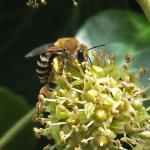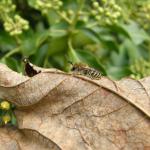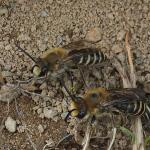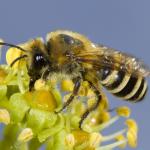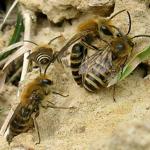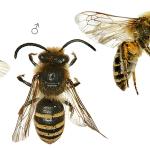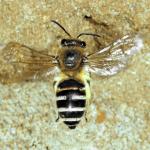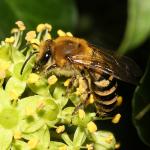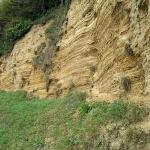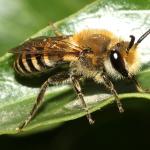A recent addition to the list of European bees, being described as new to science in 1993. Previously this bee had been misidentified as both Colletes halophilus and C. succinctus by various authors. It is very closely related to both of these species, especially C. halophilus.
Link to Colletes hederae mapping project here.....
A recent arrival in Britain, with the first confirmed records from Dorset in 2001. By 2016, the bee had spread across Southern England and South Wales, northwards and eastwards to colonise most of East Angla, the Thames and Severn Valleys. The species is now well established in South Wales and in 2014 was recorded in north Wales for the first time. Since the 2016 season, there has seen expansion northwards with new records from Nottinghamshire, Yorkshire, County Durham (Whitburn) and southern Cumbria. Also well known from the Channel Islands with confirmed records from Alderney, Guernsey, Herm, Jersey and Sark. It is widespread elsewhere in western Europe and it appears to be spreading rapidly, with records from Austria, Belgium, Croatia, France (including Corsica), Germany, Greece, Italy (including Sardinia), Luxembourg, The Netherlands, Serbia, Slovenia, Spain and Switzerland. Previous reports from Cyprus are likely to be of the close congener C. brevigena
The map is showing the distribution as it was in 2016
This species is not regarded as being scarce or threatened in Britain
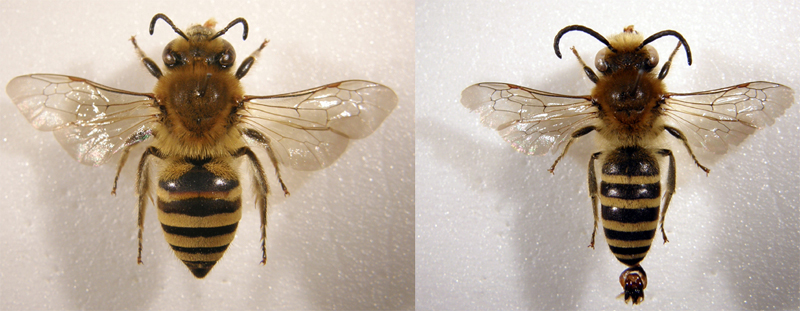
Female above left and male at right. It's fairly simple to determine Colletes hederae – It is a typical Colletes, but it can be as large as, or larger than a honeybee, and the banding on the abdomen of fresh specimens has a distinct orange hue. This fades in older specimens. Any largish Colletes visiting ivy (often in large numbers) in October is likely to be this species. (Photos: Steven Falk)
C. hederae often occurs in large nesting concentrations in soft, crumbly banks and cliffs. Males may be seen in frenzied mating clusters as they "mob" females emerging from their nests.
Inland dunes and coastal paths, though probably found wherever its pollen source is firmly established. Often an abundant bee where it does occur (G R Else, pers. obs.). Since initial establishment in the UK in 2001, nesting sites have been found in sparsely vegetated banks and paths, on urban and suburban lawns and grassy areas, roadside verges, golf courses and on soft rock cliffs and undercliffs.
Univoltine; from late August or early September to late October, occasionally the beginning of November.
Nesting aggregations are often extensive (containing several thousand nests) and have been encountered in a variety of sites, such as grassy slopes, coastal cliffs, roadside verges and gardens. In October 2006 immense numbers of nest burrows were seen in a number of adjoining gardens in Tisbury, Wiltshire. These were excavated both on lawns and in side beds (pers. obs). O’Toole (pers. comm.) found a dense nesting aggregation in Guernsey in a low earth bank above the beach, well within the spray zone. On the Channel Islands the bee is sometimes considered a pest, as numerous females excavating their nest burrows in roadside banks can lead to slumping of the soil (C O'Toole, pers. comm.).
Males, which generally far outnumber females, occasionally settle to inspect open burrows and, within very dense nesting aggregations commonly attempt copulation with each other. When female bees emerge from burrows they are often pounced upon by a number of males forming conspicuous mating clusters. Most females mate immediately on leaving their nest entrances. There they attract the attention of males that are awaiting such an event. This was demonstrated in dramatic fashion at Brownwich Cliffs, a coastal site on Southampton Water, Hampshire, in September 2010 (G R Else pers. comm.). A huge number of males were flying about the sandy cliff face though no females were immediately obvious. From time to time mating clusters would tumble down the cliff and come to rest on the more or less level ground at the base. There more males would join the cluster. Somewhere in the center was a freshly emerged female that had coupled with one of the males. After some minutes the mated pair would extricate itself and the bees would fly off in tandem. Some clusters, however, consisted only of males, perhaps as many as two dozen. Saxton (2009) describes in detail the sexual behaviour of this species near Hastings, East Sussex.
Bischoff, Eckelt and Kuhlmann (2005) studied in some detail the nesting biology of C. hederae in Germany. They found that nesting females utilised old nests and also dug new ones. Four nest burrows of this bee were excavated and studied by these authors. These first ran between 7-12 cm horizontally into a steep face, before turning downwards. The cells were located at a depth of 30-45 cm. Groups of up to four cells branched directly off the main vertical burrow and in most instances side branches were absent.
Both sexes visit ivy (Hedera helix). On Jersey, males have been observed visiting heather (Calluna vulgaris) flowers close to a nesting aggregation of this bee (B Bolton, pers. comm.).
None known in Britain. Elsewhere in Europe the Meloid beetle Stenoria analis is a parasite of the bee in the Channel Islands, Belgium and France but has not yet been found in Britain. There is evidence that patrolling males of C. hederae hover in front of, and are strongly drawn to, larval aggregations of S. analis in a manner reminiscent of approaching flights to emerging, conspecific females. Not only are the male bees strongly attracted by clusters of newly hatched triungulins, but they also attempted copulation (i.e., pseudocopulation) with the latter, which regularly resulted in small groups of triungulins being transferred onto the thorax of the male bees. Decent-sized groups of triungulins were exclusively found on the thorax of male bees, which suggests that triungulins of S. analis lure only males of the targeted host species, presumably by mimicking the female pheromonal cues of C. hederae. This is the first record of this kind of interaction for the whole West-Palaearctic, and only the second account on sexual deception between blister beetles and wild bees described to date.The triungulin larva of the beetle eventually slip off the bee and consume the food store of nectar and pollen that the female bee has prepared for its larva. (N J Vereecken & G Mahé, 2007).
In south-west Slovenia, Gogala (pers. comm) has observed the cleptoparasitic bee Epeolus cruciger associating with C. hederae and Epeolus cruciger was also found to be a common parasite of C. hederae in southern Switzerland (Ticino) as well as in the Monte Gargano area in Puglia (Italy) (A Müller pers. comm.). In southern France, it is suggested that Epeolus fallax may well be associated with C. hederae (P Westrich pers. comm.).
Profile written: 2001; Updated: December 2011; Updated: October 2016; November 2019


